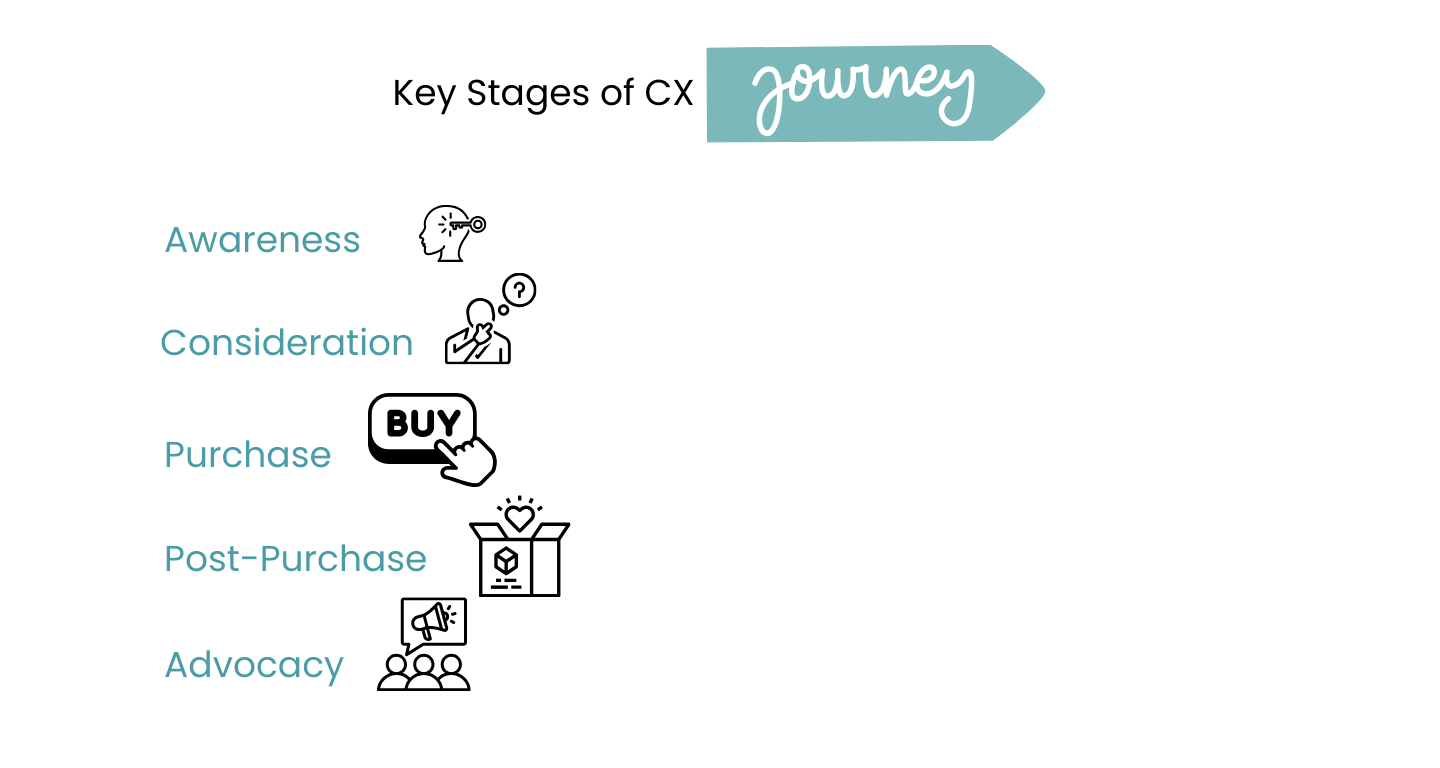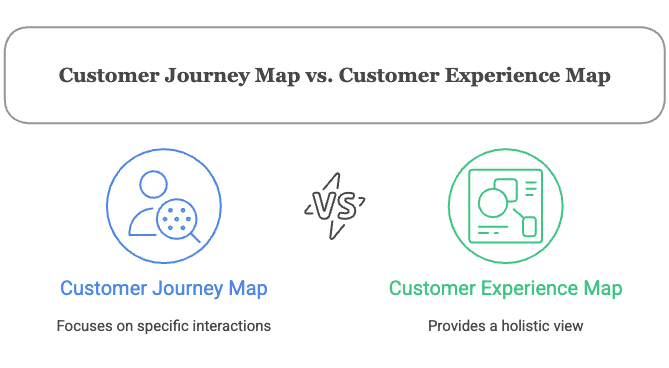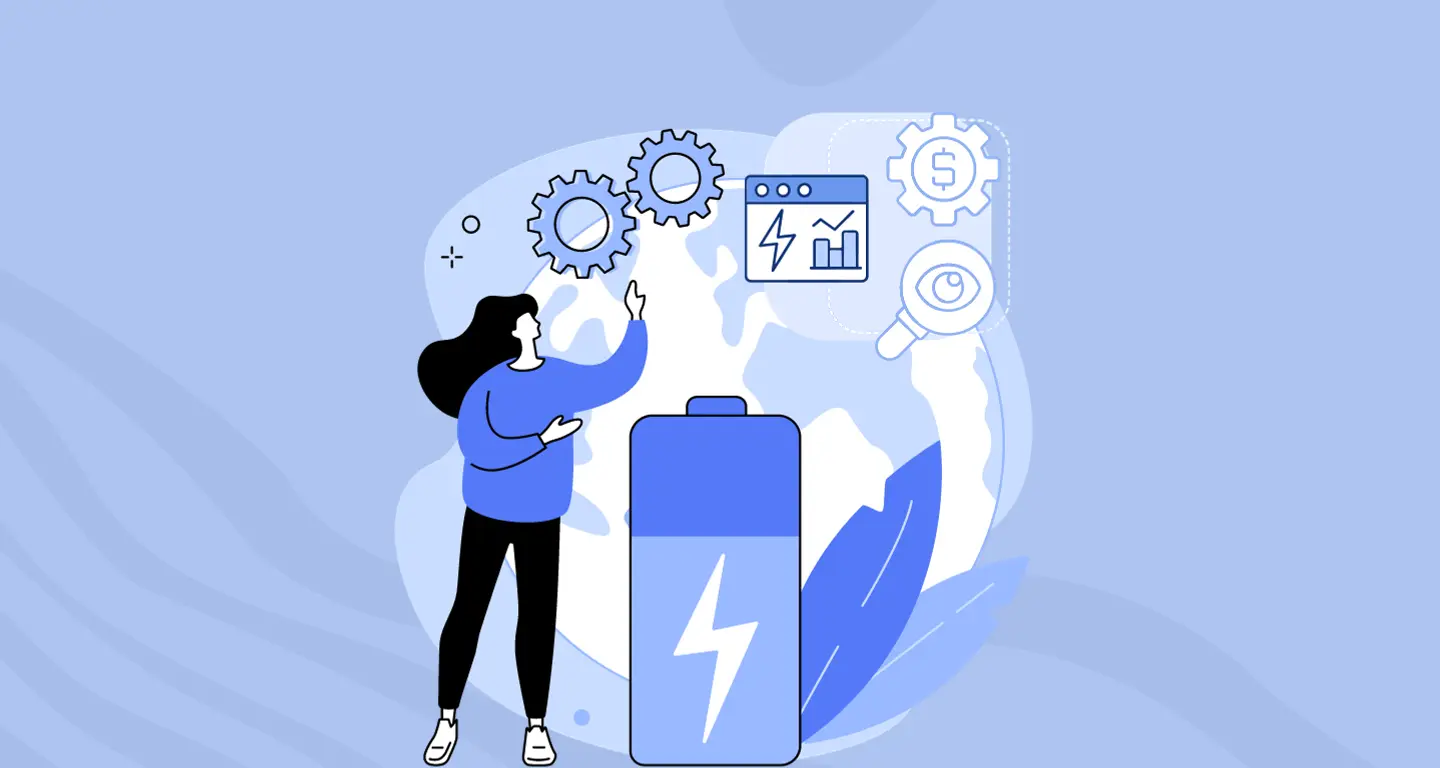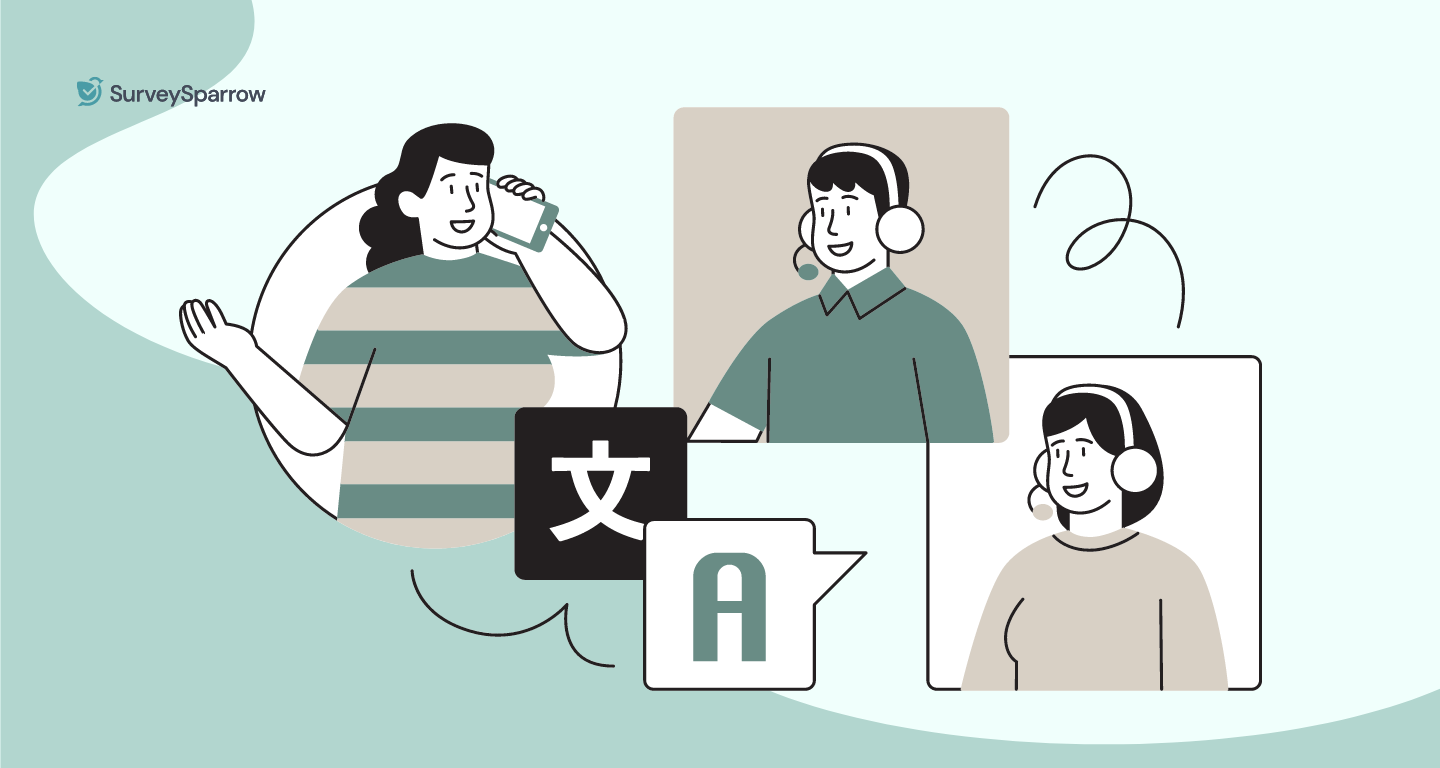Customer Experience
B2B Customer Experience Journey: Stages, Examples & CX Strategies
Article written by Kate Williams
Content Marketer at SurveySparrow
13 min read
16 December 2025

When customers visit your website, request a demo, or walk into your store, they arrive with a clear objective—a problem to solve or a goal to achieve.
Now imagine a busy professional evaluating multiple vendors at once. They’re short on time, comparing options, and looking for clarity. What makes them choose your solution—and continue working with you long term?
The answer lies in how well you understand and optimize the B2B customer journey and the broader customer experience journey that surrounds it.
Let's start with the basics.
What is a Customer Experience Journey?
The customer experience journey is the complete, end-to-end experience a customer has with a brand; from the first interaction to long-term loyalty and advocacy.
It includes:
- Every touchpoint (website, email, sales calls, support)
- Every channel (online and offline)
- Every emotion, expectation, and perception along the way
In a B2B customer journey, this experience is often longer and more complex. It usually involves multiple stakeholders along with decision-makers, longer sales cycles, and higher expectations around value, trust, and consistency. A well-designed customer experience journey enables businesses to deliver seamless, personalized, and consistent experiences, leading to higher satisfaction, retention, and lifetime value.
The B2B customer journey is the complete path a business buyer takes—from first awareness to long-term partnership—across every interaction, channel, and touchpoint.
Why the B2B Customer Experience Journey Matters
Customers today have endless choices. Products, features, and pricing can be copied quickly. What can’t be replicated is the experience you create for your customers.
Optimizing the B2B customer journey helps businesses:
- Understand customer needs at every stage
- Reduce friction across marketing, sales, and support
- Align internal teams around a shared customer view
- Build trust throughout long decision cycles
In short, the customer experience journey has become a critical growth lever for B2B organizations.
Key Stages of the B2B Customer Experience Journey
While journey models may vary, most B2B customer experience journeys follow these core stages. Mapping each stage gives you insight into:
- Customer expectations
- Pain points and objections
- Opportunities to improve experience and conversion

Let’s dive a little deeper. We’ll also see what strategy will help improve the customer journey funnel:
Awareness
This is where the B2B customer journey begins. Customers recognize a problem and start looking for solutions. During this stage, your goal is to capture the attention of potential customers and make them aware of your brand. Your goal here is to stay visible, be relevant, and be helpful.
Implement the following strategies to stand out:
- Craft compelling brand messaging that resonates with your target audience.
- Leverage digital marketing channels such as social media, content marketing, and search engine optimization (SEO) to increase brand visibility.
- Utilize surveys and feedback tools, like SurveySparrow, to gather customer insights and understand their preferences. Moreover, a conversational form will engage the audience and create curiosity. Oh, don’t take my word for it. Check this template out.
Customer Experience Survey Template
Use This Template(Feel free to use this customizable template)
Consideration
In the consideration stage, customers evaluate different options and compare them. You need to aim to build confidence and gain their trust. What works best:
- Provide detailed product/service information and address common pain points through informative content, product guides, and demos.
- Offer personalized recommendations based on their preferences and previous interactions.
- Incorporate social proof elements such as testimonials and case studies to build trust.
This stage often determines whether customers move forward or drop off.
Decision/Purchase
When customers are ready to make a purchase, ensuring a smooth and frictionless experience is crucial. Your goal is to make the decision easy. Consider the following strategies:
- Streamline the checkout or sign-up process
Reduce unnecessary steps and offer multiple payment options to match different buyer preferences. - Be transparent with pricing and policies
Clearly communicate pricing, contracts, shipping, renewals, and return policies to avoid last-minute hesitation. - Provide real-time support when questions arise
Buyers often have final clarifications before committing. Conversational support like live chat or AI agents like Echo by SurveySparrow, which can answer questions and route requests instantly—helps resolve uncertainty without slowing the purchase.
Once they’ve purchased or chosen your service, it’s time for the post-purchase stage. This is where the real magic happens. By leveraging powerful feedback tools, you can gather valuable insights and provide exceptional customer support, ensuring a delightful experience every step of the way.
Most businesses work hard to make the purchase stage seamless, but after the transaction, many are still left guessing about what customers actually felt, what slowed them down, or what could’ve made the experience better. And when you don’t have clear insight into those moments, you’re forced to rely on assumptions instead of real signals.
When you fix that, the entire customer journey changes. Every interaction becomes a chance to learn, every touchpoint becomes a moment to improve, and loyalty starts to grow naturally. All solely because you’re responding to what customers actually need, not what you think they need.
That’s exactly what SurveySparrow is built for. For real-time feedback systems, conversational surveys, and AI-powered insights that turn post-purchase moments into opportunities for clarity, connection, and continuous improvement.
Ready to elevate your customer journey?
Start simplifying decisions, strengthening loyalty, and creating experiences your customers will remember.
14-day free trial • Cancel Anytime • No Credit Card Required • No Strings Attached
Post-Purchase / Service
In the B2B customer experience journey, post-purchase is where value is proven. Your goal is to deliver quick wins and confidence. Post-sales support and service play a vital role in customer satisfaction and loyalty. Implement these strategies to provide exceptional service:
- Offer prompt and personalized customer support through various phone, email, and chat channels.
- Proactively seek feedback and promptly address customer issues to showcase your commitment to their satisfaction.
- Leverage automation tools to streamline support processes and ensure consistent service delivery.
Read More: Post Purchase Experience: Meaning, Benefits, and Ways to Improve
Loyalty and Advocacy
In this final stage, the goal is to convert satisfied customers into loyal advocates who actively promote your brand. Implement these strategies to foster loyalty:
- Create a loyalty program to reward customers for their continued support and engagement.
- Encourage customers to leave reviews and ratings on review platforms.
- Create a sense of community through engaging content, exclusive offers, and personalized communication.
Read More: What is Customer Advocacy and 10 Reasons Why It Matters
Regardless of the stage your customers are in, it is important to communicate for better understanding. Transactional surveys are key in such cases.
If you are in the online market, either embed an in-app survey or roll out email or SMS surveys. If you’re a retail store or an offline business, try keeping a QR of a survey at the cash counter for quick follow-up. Further, follow the same process and roll out recurring surveys to keep track.
With SurveySparrow, you can do all this and more! You can create engaging surveys with the drag-and-drop form builder or customize the 1000+ pre-designed templates. Share the surveys through the mode of your choice and collect data. You can visualize the customer journey- the metrics and initiatives- in one place.
Create a customer journey map with Survey Sparrow, and pay attention to every detail. Why don’t you try it out for free today?
Sign up today for better insights!
14-day free trial • Cancel Anytime • No Credit Card Required • No Strings Attached
Importance and Benefits of Customer Experience Journey
Optimizing the b2b customer experience journey isn’t just about creating pleasant interactions. It directly impacts revenue, retention, and operational efficiency.
When businesses understand how customers move across touchpoints, and where experiences break down; they can design journeys that work for both customers and internal teams.
Here’s how a well-optimized customer experience journey delivers measurable outcomes.
Higher Customer Lifetime Value (CLV)
Many businesses focus heavily on acquisition, but growth compounds when customers stay longer and expand their relationship with your brand.
By mapping the customer experience journey, brands can:
Identify repeat-purchase opportunities
Surface moments for cross-sell and up-sell
Remove friction that quietly erodes loyalty
For example, in an eCommerce setup, a complicated checkout or unclear return policy may seem minor, but in reality, it often becomes the reason customers don’t come back. Fixing these moments creates trust, and trust drives repeat revenue.
Reduced Customer Churn
Churn rarely happens overnight. It’s usually the result of unaddressed friction across the journey.
Most CX teams collect feedback, but the problem is this:
Responses sit in dashboards
Issues are spotted too late
Patterns remain unclear
When feedback isn’t captured at the right touchpoints, or not followed up on quickly, customers feel unheard.
When you fix that, feedback becomes an early-warning system. You spot friction faster, respond sooner, and retain customers longer.
That’s where conversational, always-on feedback loops make a difference, helping teams listen continuously instead of waiting for quarterly surveys.
Notice your favorite OTT platform? They provide personalized recommendations, a seamless UX, and responsive customer support.. it's all the result of observing your every action!
Competitive Advantage in B2B Market
In crowded B2B markets, products often look similar. Pricing can be matched. Features can be replicated. Experience is a lot harder to copy, because it's almost extremely personalized.
Brands that prioritize the B2B customer journey stand out by:
Making complex decisions easier
Communicating clearly at every stage
Delivering consistency across teams and channels
Take Airbnb. Its success didn’t come from inventory alone—it came from obsessing over the end-to-end experience, from discovery to post-stay feedback.
That same principle applies in B2B. A smoother experience becomes your differentiator.
Cost Reduction
Disconnected journeys are expensive. When touchpoints aren’t aligned, it results in increased support tickets, repeat issues, and teams waste time switching tools. Optimizing the customer experience journey reduces costs by:
- Preventing issues before they escalate
- Improving first-contact resolution
- Increasing referrals and retention
For example, clear policies, proactive communication, and timely feedback collection can significantly reduce service overhead—while improving satisfaction at the same time.
Read More: The 5 Stages of the eCommerce Customer Journey
CX Journey Mapping Explained
Ever wondered what customer journey mapping is? What’s the big deal about it, and why is it important?
Customer experience journey mapping is a strategic process that involves visualizing and understanding the end-to-end interactions customers have with a brand. It enables businesses to gain deep insights into the customer’s perspective, identify pain points, and create personalized experiences that leave a lasting impact.
- Visualizing the Customer’s Path: Customer experience journey mapping involves creating a visual representation of the customer’s entire journey, from the initial touchpoints to post-purchase interactions.
- Understanding Customer Needs: By mapping the journey, businesses can gain a holistic understanding of customer needs, expectations, and emotions at each stage.
- Identifying Pain Points and Opportunities: Journey maps help identify pain points and areas where customers may face difficulties or frustrations. This enables businesses to proactively address these issues and turn them into opportunities for improvement.
- Personalizing Experiences: By understanding the customer’s journey, businesses can tailor their interactions, communications, and offerings to meet specific needs and preferences.
- Enhancing Customer Satisfaction and Loyalty: A well-designed customer experience journey leads to enhanced customer satisfaction, loyalty, and advocacy, ultimately driving business growth.
Read More: Exploring Customer Journey Mapping – An Interview with Jim Tincher
Difference between Customer Journey Map and Customer Experience Map
While the terms “customer journey map” and “experience map” are often used interchangeably, they have distinct differences.

Customer Journey Map:
- Focuses on the specific interactions and touchpoints a customer goes through during their engagement with a brand.
- Illustrates the customer’s steps, actions, and emotions at each touchpoint.
- Helps identify pain points, bottlenecks, and areas for improvement within the customer’s journey.
- Enables businesses to optimize individual touchpoints to enhance the overall experience.
Customer Experience Map:
- Takes a broader perspective, encompassing the entire customer experience from end to end.
- Considers both external touchpoints and internal processes that influence the customer’s perception.
- Provides a holistic view of the customer’s journey, highlighting the various channels, departments, and systems involved.
- Helps businesses understand the overall customer experience and identify opportunities for seamless and consistent experiences across all touchpoints.
Read More: Customer Journey vs Customer Experience: A Comparison
Conclusion
The customer experience journey is no longer a “CX initiative”. It’s a growth strategy. Businesses that win don't just collect feedback, they listen continuously, understand the why behind the customer behaviour, and act on those insight in real time.
When feedback stops being noise and starts becoming direction, teams move faster, customers stay longer, and experiences improve naturally.
That’s the approach SurveySparrow is built around; helping teams capture richer insights, close the loop faster, and optimize the B2B customer journey at scale.
Start mapping your customer journeys. Sign up for free today!
14-day free trial • Cancel Anytime • No Credit Card Required • No Strings Attached

Make your customers feel heard. Turn feedback into loyalty with SurveySparrow's CX platform.
Kate Williams
Frequently Asked Questions (FAQs)
It involves tracking and analyzing customer touchpoints with a business throughout its buying journey. It helps businesses understand customer behavior and preferences to improve marketing, sales, and overall customer experience.
In B2B and e-commerce, customer journey metrics like conversion rates, acquisition costs, and satisfaction scores track the effectiveness of marketing, sales, and user experiences. They guide optimization efforts, helping businesses improve processes, reduce friction points, and drive growth.
It involves ongoing efforts to ensure customers achieve their desired outcomes and derive value from their products or services. It focuses on proactive engagement, support, and building long-term relationships.
Related Articles
![Great Customer Service: 7 Proven Strategies & 5 Email Templates [2025 Guide] Great Customer Service: 7 Proven Strategies & 5 Email Templates [2025 Guide]](/_next/image/?url=https%3A%2F%2Fsurveysparrow.com%2Fwp-content%2Fuploads%2F2021%2F01%2Fgood-customer-service.jpg&w=3840&q=75)
Customer Experience
Great Customer Service: 7 Proven Strategies & 5 Email Templates [2025 Guide]
16 MINUTES
31 January 2021

Customer Experience
Tips To Ace Personalized Customer Experiences Like Industry Leaders
8 MINUTES
28 June 2023

Customer Experience
Enhancing Customer Experience in Utilities: A Comprehensive Guide
8 MINUTES
26 September 2023

Customer Experience
Customer Adoption: Benefits, Tools, Strategies, & Metrics
17 MINUTES
4 April 2024
